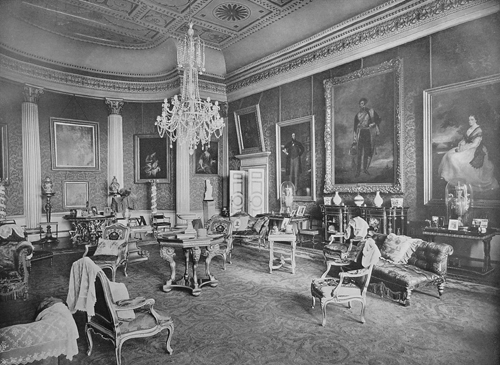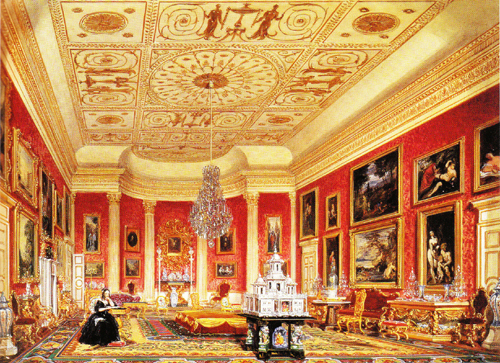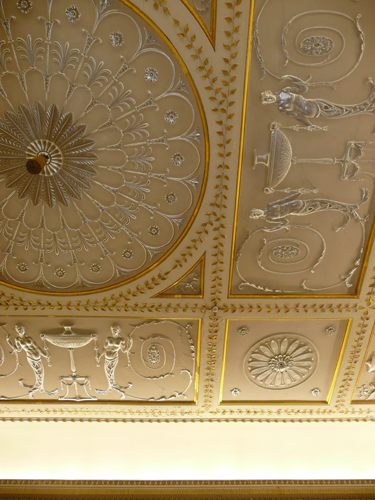
Brief history of the State Drawing Room and its decoration1
From the rebuilding of 1774 until 1922 this room was known as the State Drawing Room. It is now known as the Temple Room. It is to the west of the Marble Saloon and is about 30 by 40 feet (9m x 12m), with an apse in the centre of the north wall. There are doors at each end of the side walls, though only the northern pair are real, the other two being false. The plaster ceiling is probably a design of Vincenzo Valdrè and was executed by James Lovell, whose bill dates from 1776. It is decorated in neo-classical style with a symmetrical arrangement of Nereids, tazzas, paterae and other motifs, originally the details were gilt but this was replaced by aluminium leaf in the 1965 restoration.
The original marble fireplace dated from 1777 was sold in 1922 and is now in the headquarters of the Banco de Santander, in Spain. It contained an antique alabaster bas-relief from Egypt of a Sacrifice to Bacchus.

The north wall has engaged fluted Corinthian columns of wood flanking the apse and a further two within it, there are quarter columns in the corners of the room. These were executed in May 1777 and are believed to have been inspired by the only available engraving of a Greek Corinthian capital, at the time, in James Stuart’s Antiquities of Athens.2
The room contained some of the finest paintings in the collection. In 1838 there were fifty two paintings hanging on the walls, including works by Rubens, Nicholas Poussin, Murillo, Albert Cuyp, David Teniers the Younger and Domenichino, these are now distributed across museums in Britain and America. Also in the room were many pieces of Sèvres porcelain of the over 200 in the collection, but these were sold in 1848. The furnishings included several pieces from the Doge’s Palace, in Venice, which are now in other British collections and museums.

Watercolour by Joseph Nash for Queen Victoria’s Album after her visit of 1845.
(The Royal Collection. Her Majesty Queen Elizabeth II).
Rearranged for the visit of Queen Victoria in 1845 the room so impressed her that she sent Joseph Nash to Stowe to record it for the Queen’s Album. The resulting watercolour is in The Royal Collection and shows the decorative scheme quite well.
The Accounts suggest that the room was plastered in 1779. It is known that a red damask was hung on the walls from soon after 1781 to 1848. In view of the short length of time following the plastering it is thought that this must have been the first decorative scheme.
The extracts from the Seeley Guide of 17973 suggests that the room was hung with orange coloured damask. This could either mean that the room had been redecorated since ca.1781 or that the damask appeared more orange than the crimson recorded in the 1780 Seeley Guide.
The watercolour from 1845 shows what appears to be red damask in the context of off-white joinery with gilding. The ceiling also appears to have been painted off-white and gilded.

A photograph of the room from the 1921 sale catalogue (see above) also appears to show the walls either hung with damask or a wallpaper with a damask design.
The present decoration consists of a yellowish paint on the walls and a white paint on the joinery. Many of the mouldings of the joinery have been painted with metallic paint, which has discoloured and turned brown with age.
The ceiling is painted in a pinkish colour and is quite distinctive with its part-gilded and part-silvered mouldings. It is known that the scheme on the ceiling dates from 1965 when aluminium leaf was applied to a number of the elements.

The existing aluminium leaf can be seen at the top.
Below that is a gilded scheme and below that is a scheme in silver leaf.
Notes
1 Michael Bevington. Stowe House. Paul Holberton Publishing. 2002.
2 James Stuart and Nicholas Revett published their work The Antiquities of Athens and Other Monuments of Greece in 1762.
3 Benton Seeley’s guidebook: ‘Stowe: A Description of the Magnificent House and Gardens of The Right Honourable Richard Grenville Temple, Earl Temple… Embellished with a General Plan of the Gardens, and also a separate Plan of each Building, with Perspective Views of the same.’1797 edition. It went through seventeen editions between 1744 and 1797.
The Stowe House Preservation Trust was founded in 1997 in order “to restore and preserve Stowe House for the benefit of the nation and the public.” The school remains as a tenant and the house is opened to the public on more than 200 days per year.
View Larger Map











No comments yet. Be the first!